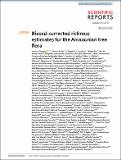Biased-corrected richness estimates for the Amazonian tree flora
Abstract
Amazonian forests are extraordinarily diverse, but the estimated species richness is very much debated. Here, we apply an ensemble of parametric estimators and a novel technique that includes conspecific spatial aggregation to an extended database of forest plots with up-to-date taxonomy. We show that the species abundance distribution of Amazonia is best approximated by a logseries with aggregated individuals, where aggregation increases with rarity. By averaging several methods to estimate total richness, we confirm that over 15,000 tree species are expected to occur in Amazonia. We also show that using ten times the number of plots would result in an increase to just ~50% of those 15,000 estimated species. To get a more complete sample of all tree species, rigorous field campaigns may be needed but the number of trees in Amazonia will remain an estimate for years to come.
Citation
ter Steege , H , Prado , P I , Lima , R A F D , Pos , E , de Souza Coelho , L , de Andrade Lima Filho , D , Salomão , R P , Amaral , I L , de Almeida Matos , F D , Castilho , C V , Phillips , O L , Guevara , J E , de Jesus Veiga Carim , M , Cárdenas López , D , Magnusson , W E , Wittmann , F , Martins , M P , Sabatier , D , Irume , M V , da Silva Guimarães , J R , Molino , J F , Bánki , O S , Piedade , M T F , Pitman , N C A , Ramos , J F , Monteagudo Mendoza , A , Venticinque , E M , Luize , B G , Núñez Vargas , P , Silva , T S F , de Leão Novo , E M M , Reis , N F C , Terborgh , J , Manzatto , A G , Casula , K R , Honorio Coronado , E N , Montero , J C , Duque , A , Costa , F R C , Castaño Arboleda , N , Schöngart , J , Zartman , C E , Killeen , T J , Marimon , B S , Marimon-Junior , B-H , Vasquez , R , Mostacedo , B , Demarchi , L O , Feldpausch , T R & Hoffman , B 2020 , ' Biased-corrected richness estimates for the Amazonian tree flora ' , Scientific Reports , vol. 10 , 10130 . https://doi.org/10.1038/s41598-020-66686-3
Publication
Scientific Reports
Status
Peer reviewed
ISSN
2045-2322Type
Journal article
Description
This paper is the result of the work of hundreds of different scientists and research institutions in the Amazon over the past 80 years. Without their hard work this analysis would have been impossible. We thank Charles Zartman for the use of plots from Jutai. HtS, VFG, and RS were supported by grant 407232/2013-3 - PVE - MEC/MCTI/CAPES/CNPq/FAPs; PIP had support for this work from CNPq (productivity grant 310885/2017-5) and FAPESP (research grant #09/53413-5); RAFL was supported by the European Union’s Horizon 2020 research and innovation program under the Marie Skłodowska-Curie grant agreement No 795114; CB was supported by grant FAPESP 95/3058-0 - CRS 068/96 WWF Brasil - The Body Shop; DS, JFM, JE, PP and JC benefited from an “Investissement d’Avenir” grant managed by the Agence Nationale de la Recherche (CEBA: ANR-10-LABX-25-01); HLQ/MAP/JLLM received financial supported by MCT/CNPq/CT-INFRA/GEOMA #550373/2010-1 and # 457515/2012-0, and JLLM were supported by grant CAPES/PDSE # 88881.135761/2016-01 and CAPES/Fapespa #1530801; The Brazilian National Research Council (CNPq) provided a productivity grant to EMV (Grant 308040/2017-1); Floristic identification in plots in the RAINFOR forest monitoring network have been supported by the Natural Environment Research Council (grants NE/B503384/1, NE/ D01025X/1, NE/ I02982X/1, NE/F005806/1, NE/D005590/1 and NE/I028122/1) and the Gordon and Betty Moore Foundation; BMF is funded by FAPESP grant 2016/25086-3. BSM, BHMJ and OLP were supported by grants CNPq/CAPES/ FAPS/BC-Newton Fund #441244/2016-5 and FAPEMAT/0589267/2016; TWH was funded by National Science Foundation grant DEB-1556338.The 25-ha Long-Term Ecological Research Project of Amacayacu is a collaborative project of the Instituto Amazónico de Investigaciones Científicas Sinchi and the Universidad Nacional de Colombia Sede Medellín, in partnership with the Unidad de Manejo Especial de Parques Naturales Nacionales and the Center for Tropical Forest Science of the Smithsonian Tropical Research Institute (CTFS). The Amacayacu Forest Dynamics Plot is part of the Center for Tropical Forest Science, a global network of large-scale demographic tree plots. We acknowledge the Director and staff of the Amacayacu National Park for supporting and maintaining the project in this National Park.Collections
Items in the St Andrews Research Repository are protected by copyright, with all rights reserved, unless otherwise indicated.

